
FS-987 | June 2014
Choosing the Best Poultry Breed for Your Small Farm
By Jonathan Moyle, Jessica Flores, and Dustan Clark
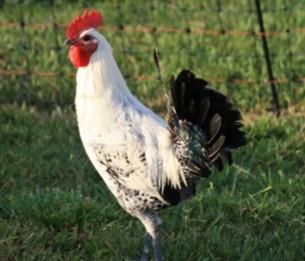
Deciding on your goal for raising chickens is the first step in determining which breed is best for your farm. The most common reasons as to why people raise chickens include: egg production, meat production, raising birds for show, controlling insects around their property, and breed preservation.
Knowing your market will also help you decide on the best breed. If you are selling eggs, what size and color do your customers want: white, brown, blue-green? For meat production, do you want yellow or white skin? Or maybe your customers would like birds with black skin and meat. You will need to answer all of these questions in order to determine the optimal breeds for your operation.
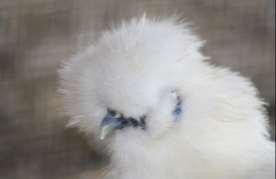
Chickens are traditionally classified into groups based on size, where the breed originated, shape, feather color, and type of comb. Chickens come in two sizes: large fowl (sometimes incorrectly referred to as “standard”) or bantams, which are usually ¼ to ⅕ of the size of large fowl. Most bantams are smaller versions of the large breeds; however, some bantam breeds like Silkies, have no larger counterpart. While bantams do not grow to the size of large fowl, they can still be used to produce a good quantity of small eggs.
Additional classification terms that are used include:
- CLASS - refers to groups of birds from a common geographical area such as: American, Asiatic, English, Mediterranean, Continental and All Other Standard Breeds.
- BREED - birds within a class that differ in body shape or size, skin color, number of toes or feathering on their legs.
- VARIETY - birds within a breed that differs in feather color or pattern, in the type of comb, or the presence of a beard.
- STRAIN - birds within varieties that are developed for specific traits such as egg production, egg color, or meat production.
Other important terms to be familiar with include:
- BROODY – when the hen wants to sit on the eggs and hatch them. This also includes taking care of the young as well. Hens that become broody do not lay eggs and are therefore out of production.
- FORAGE – the ability to find their own feed, such as insects and plant material.
Climate is another important consideration when looking at different breeds. Some chickens do better in cold climates while others do better in hot climates. For example, Mediterranean breeds generally do well in hot humid climates while most breeds from the American and English classes do better in cooler climates. Typically, birds with large combs will perform better in warmer climates because the combs help the birds to cool better. However, large combs are a problem in cold climates as they can get frost bite. Many breeds have varieties with different combs so if you want a particular breed, you can select the variety that is best for your climate area.
While birds that are selected for growth and meat quality typically are not suited for laying eggs, some “dual purpose” breeds have been selected for both growth and eggs. These breeds will lay a good number of eggs and produce a good carcass for meat consumption.
Dual Purpose
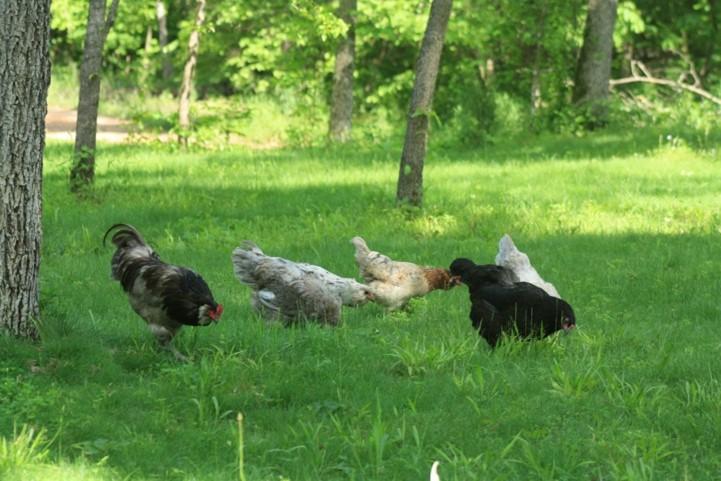
Dual purpose breeds are what most people think of when they think about poultry raised on small family farms. While dual purpose birds lay and grow well, they are not the best choice for small farm enterprises. Most of these birds will go broody to some extent, but it depends on what the birds were selected for. Those that lay well, for example, will typically not go as broody as birds selected for growth. This is because broody hens lay fewer eggs so selecting birds for egg production tends to produce hens that are less likely to become broody. Most dual-purpose breeds have strains that either will be better at growing or laying. Do your homework and learn about the various breeds and their characteristics and uses.
| Breed | Egg Production | Egg Size | Egg Color | Disposition | Foraging Ability |
|---|---|---|---|---|---|
| Plymouth Rock | Fair | Large | Brown | Calm | Fair |
| Rhode Island Red | Good | Large | Brown | Calm | Fair |
| Dominique | Fair | Medium | Brown | Calm | Good |
| Delaware | Fair | Large | Brown | Calm | Good |
| Wyandotte | Fair | Large | Brown | Calm | Fair |
| Brahma | Fair | Large | Brown | Calm | Good |
| Orpington | Fair | Large | Brown | Calm | Poor-Fair |
Egg Layers
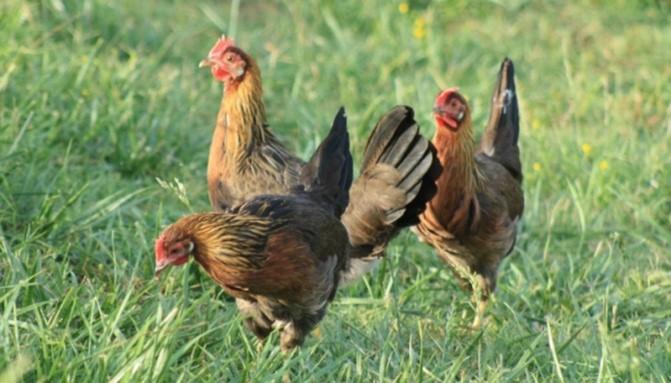
Typically, most layers are medium to small in size and do not produce a good carcass for consumption, as the conversion of feed to meat is poor. These birds are the most efficient at converting feed into eggs and are the best choice for those wanting to sell eggs. While most egg laying birds have been selected to not go broody, some breeds still have a few strains that will.
| Breed | Egg Production | Egg Size | Egg Color | Disposition | Foraging Ability | Broody |
|---|---|---|---|---|---|---|
| Leghorn | Excellent | Large | White | Very Active | Good | No |
| Minorca | Excellent | X Large | White | Active | Good | No |
| Australorp | Excellent | Large | Brown | Calm | Poor | Yes |
| Ancona | Good | Large | White | Active | Good | No |
| Ameraucana | Good | Large | Blue-green | Calm | Good | Yes |
| Hamburg | Good | Small | White | Very Active | Good | No |
| Fayoumi | Good | Small | Tinted White | Very Active | Excellent | Some |
| Maran | Good | Large | Dark Brown | Active | Poor | Yes |
| Sex-link | Excellent | Large | Brown | Calm | Poor | No |
Meat Breeds
Meat breeds are very poor layers and usually not kept for egg production. These breeds will grow faster than most large fowl breeds but not nearly as fast as commercial broilers. Additionally, meat breeds are not as efficient at converting feed to muscle as broilers, making the cost of production higher than broilers. If you want a slower growing, more colorful breed, consider one of the following:
| Breed | Growth Rate | Skin Color | Disposition | Foraging Ability |
|---|---|---|---|---|
| Cornish | Slow-Medium | Yellow | Calm | Poor |
| Jersey Giant | Medium | Yellow | Calm | Poor |
| New Hampshire | Fast | Yellow | Calm | Poor |
| Freedom Rangers | Fast | Yellow | Calm | Fair |
| Modern Broilers | Very Fast | Yellow | Calm | Poor |
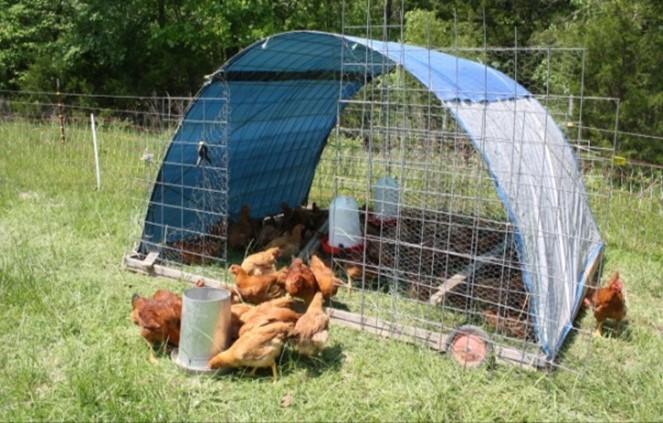
Disposition
There is a lot of variation in the disposition of individual birds. While breeds as a whole may be calm or active, individuals within the breed may be very different. Males in particular can become very aggressive toward people and especially to younger children, so care must be taken when they are around. The foraging ability also will vary by individual and by how the birds are managed. For example, if birds are not given the feed that their bodies need, they will forage more to make up the difference. This is especially true of broilers, who are the “couch potatoes” of the chicken world.
There are almost 400 breeds and varieties of chickens that can be reared for exhibiting at poultry shows, for food production or to simply roam around the farm looking for bugs. They come in a wide range of colors and sizes to fit every need. If all you want are a few birds to keep the bugs down around the house, then consider one of the breeds on the American Livestock Breeds Conservancy list (https://livestockconservancy.org/heritage-breeds/poultry-breeds/).
Finally, before selecting and acquiring the type of chickens that you want to own, make sure that you:
- Know how to care for them.
- Check if your local laws or town ordinances allow chickens at your location. Many cities are now allowing birds inside city limits, but have restrictions on the number that can be kept, along with whether roosters are allowed or not. Additionally, some cities do not allow growers to perform home slaughter of poultry or other livestock, so be sure to check the regulations before you start.
- Have a way to get rid of the chicken manure safely and legally.
- Have fun! Raising chickens is an excellent way to teach children about how to care for animals and produce their own food.
JONATHAN MOYLE
jmoyle@umd.edu
JESSICA FLORES
DUSTAN CLARK
This publication, Choosing the Best Poultry Breeds for your Small Farm (FS-987), is a part of a collection produced by the University of Maryland Extension within the College of Agriculture and Natural Resources.
The information presented has met UME peer-review standards, including internal and external technical review. For help accessing this or any UME publication contact: itaccessibility@umd.edu
For more information on this and other topics, visit the University of Maryland Extension website at extension.umd.edu
University programs, activities, and facilities are available to all without regard to race, color, sex, gender identity or expression, sexual orientation, marital status, age, national origin, political affiliation, physical or mental disability, religion, protected veteran status, genetic information, personal appearance, or any other legally protected class.
When citing this publication, please use the suggested format:
Moyle, J., Flores, J., & Clark, D. (2014). Choosing the Best Poultry Breeds for Your Small Farm (FS-987). University of Maryland Extension. go.umd.edu/FS-987